
If you are planning to go for an outing with friends or family, you will be appreciated by your companions in selecting Chikkamagaluru. No doubt in that. Chikkamagaluru is the place where coffee was first cultivated in India. As one of the district in Karnataka State, the word Chikkamagaluru literally means “The town of the younger daughter” in the native Kannada language. The town is said to have been given as a dowry to the younger daughter of Rukmangada, the legendary chief of Sakrepatna and hence the name. As one can guess, there is indeed a town called Hiremagaluru which means “the town of the elder daughter” which is about five Kilometer from Chikkamagaluru city.
The mountains here which are a part of the Western Ghats are the source of rivers like Tunga and Bhadra. Hill stations like Kemmanagundi and Kudremukh and waterfalls like Manikyadhara and Kallathigiri are giving Chikkamagaluru the status of tourist’s paradise. Kudremukh National Park and Bhadra Wildlife Sanctuary are really interesting to the wildlife enthusiasts.
Coffee was introduced into India through the Chikkamagaluru district when the first coffee crop was grown in the Baba Budan Giri Hills during 1670 AD. According to the article Origins of Coffee, the saint Baba Budan on his pilgrimage to Mecca travelled through the seaport of Mocha, Yemen where he discovered coffee. To introduce its taste to India, he wrapped seven coffee beans around his belly and got them out of Arabia. On his return home, he planted the beans in the hills of Chikkamagaluru, which are now named Baba Budan Hills in his honour.
Coffee was introduced into India through the Chikkamagaluru district when the first coffee crop was grown in the Baba Budan Giri Hills during 1670 AD. According to the article Origins of Coffee, the saint Baba Budan on his pilgrimage to Mecca travelled through the seaport of Mocha, Yemen where he discovered coffee. To introduce its taste to India, he wrapped seven coffee beans around his belly and got them out of Arabia. On his return home, he planted the beans in the hills of Chikkamagaluru, which are now named Baba Budan Hills in his honour.
Kemmangundi: A scenic hill station on the Baba Budan Giri range of hills named Kemmanagundi, 55 km north from Chikkamagaluru town, is really an amusing spot to the tourists. Kemmangundi is also known as K.R. Hills after the Wodeyar King, Krishnaraja Wodeyar, who had made it his favourite summer camp. Kemmangundi, at a height of 1,434 meters, is surrounded by thick forests and a salubrious climate through out the year. It is surrounded by the Baba Budan Giri range and blessed with silver cascades of mountain streams and lush vegetation. It’s beautifully laid out ornamental gardens and enchanting mountain and valley views are a treat to the eye. Spectacular sunsets are a must see from various locations in the district, even from the Raj Bhavan. For the adventurous, Kemmangundi offers many peaks to scale and intricate jungle paths to explore. There is a place called Z-point at about 10 minutes walk from this main place which gives a nice aerial view of the Shola grass lands of the Western Ghats. Just 10 km away from Kemmangundi is Kallahathigiri falls, also known as Kalahasti falls. Water cascades down from the top of the Chandra Drona hill from a height of 122 meters amidst fascinating scenery. There is an old Veerabhadra temple dedicated to Lord Shiva, constructed in a gap between rocks. This temple can be approached after crossing the waterfall. Hebbe Falls, a beautiful waterfall is also over 10 km away from the famous hill station, Kemmangundi. Here water streams down from a height of 168 meters in two stages to form Dodda Hebbe (Big Falls) and Chikka Hebbe (Small Falls). Shanti Falls, a fabulous waterfall is on the way to Z-Point in Kemmangundi.
Kudremukh and Kudremukh National Park: 95 km southwest of Chikkamagaluru town is Kudremukh range (in Kannada Kudure = horse and mukha = face), so named because of the unique shape of the Kudremukh peak. Overlooking the Arabian sea, the broad hills are chained to one another with deep valley & steep precipices. Kadambi Falls is a waterfall located in the Kudremukh National Park.
Kudremukh and Kudremukh National Park: 95 km southwest of Chikkamagaluru town is Kudremukh range (in Kannada Kudure = horse and mukha = face), so named because of the unique shape of the Kudremukh peak. Overlooking the Arabian sea, the broad hills are chained to one another with deep valley & steep precipices. Kadambi Falls is a waterfall located in the Kudremukh National Park.
Mullayanagiri: Mullayanagiri is part of the Baba Budan Giri Hill Ranges here. It stands 1930 meters tall and is the tallest peak in Karnataka. Its height is famous mostly for watching sunsets from. It is 16 km from Chikkamagaluru town. Driving to Mullayanagiri is worth taking a risk. On the way is Sitalayanagiri where the water in the Shiva temple neither increases nor decreases. The road to Mullayanagiri is very narrow with a views from steep cliffs. Driving to the peak is not possible and includes a trek up the hill from the half way point. There is a small temple on top of the hill. From the topmost point of the hill the Arabian sea is visible on clear days. The small hillock in the temple compound is the highest point in Karnataka. It is a great trekking spot in Karnataka.
Published In Arrow magazine.
November 2007 Issue.
For more:
www.aagneyam.com/arrow
Published In Arrow magazine.
November 2007 Issue.
For more:
www.aagneyam.com/arrow

No comments:
Post a Comment